Research Progress on Tunable External Cavity Semiconductor Lasers in Visible and Near-Infrared Wavebands
Abstract
1. Introduction
2. Littrow-Type Structure TECSLs
2.1. The Structure and Principle of the Littrow-Type Structure TECSL
2.2. Research Progress of the Littrow-Type Structure TECSL
3. Littman-Type Structure TECSL
3.1. The Structure and Principle of the Littman-Type Structure TECSL
3.2. Research Progress of the Littman-Type Structure TECSL
4. Filter-Type Structure TECSL
4.1. The Structure and Principle of the Filter-Type Structure TECSL
4.2. Research Progress of the Filter-Type Structure TECSL
5. Fiber-Type Structure TECSL
5.1. The Structure and Principle of the Fiber-Type Structure TECSL
5.2. Research Progress of the Fiber-Type Structure TECSL
6. Waveguide-Type Structure TECSL
6.1. The Structure and Principle of the Waveguide-Type Structure TECSL
6.2. Research Progress of the Waveguide-Type Structure TECSL
7. Conclusions
Author Contributions
Funding
Conflicts of Interest
References
- Dupuis, R. An introduction to the development of the semiconductor laser. IEEE J. Quantum Electron. 1987, 23, 651–657. [Google Scholar] [CrossRef][Green Version]
- Hawthorn, J.C.; Weber, P.K.; Scholten, E.R. Littrow configuration tunable external cavity diode laser with fixed direction output beam. Rev. Sci. Instrum. 2001, 72, 4477–4479. [Google Scholar] [CrossRef]
- Wei, F.; Sun, Y.; Chen, D.; Xin, G.; Ye, Q.; Cai, H.; Qu, R. Tunable External Cavity Diode Laser with a PLZT Electrooptic Ceramic Deflector. IEEE Photonics Technol. Lett. 2011, 23, 296–298. [Google Scholar]
- Sato, T.; Yamaoto, F.; Tsuji, K.; Takesue, H.; Horiguchi, T. An uncooled external cavity diode laser for coarse-WDM access network systems. IEEE Photonics Technol. Lett. 2002, 14, 1001–1003. [Google Scholar] [CrossRef]
- Diep, V.N.; Marilou, C.R.; Duong, V.P.; Xuan, N.T.; Thu, V.V.; Hong, P.M. Tunable dual wavelength and narrow linewidth laser using a single solid-state gain medium in a double Littman resonator. Opt. Commun. 2021, 496, 127131. [Google Scholar] [CrossRef]
- Stry, S.; Hildebrandt, L.; Sacher, J.; Buggle, C.; Kemmann, M.; Klitzing, W. Compact tunable diode laser with diffraction-limited 1 Watt for atom cooling and trapping. High Power Diode Laser Technol. Appl. II 2004, 5336, 17–25. [Google Scholar]
- Labachelerie, M.; Passedat, G. Mode-hop suppression of Littrow grating-tuned lasers. Appl. Opt. 1993, 32, 269–274. [Google Scholar] [CrossRef]
- Long, R.; Wang, H.; Gong, Q.; Song, Z.; Feng, S. Optical feedback of semiconductor external cavity laser. Commun. Technol. 2013, 46, 142–144. [Google Scholar]
- Hard, T.M. Laser wavelength selector and output coupler. IEEE J. Quantum Electron. 1969, 5, 321. [Google Scholar] [CrossRef]
- Loh, H.; Lin, Y.; Teper, I.; Cetina, M.; Simon, J.; Thompson, J.K.; Vuletić, V. Influence of grating parameters on the linewidths of external-cavity diode lasers. Appl. Opt. 2006, 45, 9191–9197. [Google Scholar] [CrossRef] [PubMed]
- Chi, M.; Bjarlin, J.O.; Michael, P.P. Tuning range and output power optimization of an external-cavity GaN diode laser at 455 nm. Appl. Opt. 2016, 55, 2263–2269. [Google Scholar] [CrossRef] [PubMed][Green Version]
- Guo, H.; Olamax, G.T. Analysis of no mode-hop tuning of mirror-grating external-cavity diode laser. Opt. Commun. 2018, 421, 90–93. [Google Scholar] [CrossRef]
- Chen, M.; Hsiao, S.; Shen, K.; Tsai, C.; Chui, H. Single longitudinal mode external cavity blue InGaN diode laser. Opt. Laser Technol. 2019, 116, 68–71. [Google Scholar] [CrossRef]
- Kapasi, D.P.; Eichholz, J.; McRae, T.; Ward, R.L.; Slagmolen, B.J.; Legge, S.; Hardman, K.S.; Altin, P.A.; McClelland, D.E. Tunable narrow-linewidth laser at 2 μm wavelength for gravitational wave detector research. Opt. Express 2020, 28, 3280–3288. [Google Scholar] [CrossRef]
- Giraud, E.; Demolon, P.; Gresch, T.; Urio, L.; Muller, A.; Maulini, R. Room-temperature continuous-wave external cavity interband cascade laser tunable from 3.2 to 3.6 µm. Opt. Express 2021, 29, 38291–38297. [Google Scholar] [CrossRef]
- Zhao, H.; Jiang, L.; Li, L.; Li, M.; Wang, R.; Yang, Z.; Wang, H.; Yang, W.; Zhang, C.; Hua, W.; et al. Wide-Spectrum Tuning and Narrowing of 780 nm Broad-Area Diode Laser with Littrow-Type Transmission Gratings. Photonics 2024, 11, 948. [Google Scholar] [CrossRef]
- Hu, Y.; Chang, Z.; Wang, P.; Hu, C.; Peng, H.; Xiao, Y.; Tang, X. Characterizing and manipulation of the modes of a blue laser diode with a double-grating external cavity. Opt. Laser Technol. 2025, 190, 113184. [Google Scholar] [CrossRef]
- Luo, W.; Duan, C. A broadband pulsed external-cavity quantum cascade laser operating near 6.9 µm. Chin. Phys. Lett. 2016, 33, 59–61. [Google Scholar]
- Sun, H.; Menhart, S.; Adams, A. Calculation of spectral linewidth reduction of external-cavity strong-feedback semiconductor lasers. Appl. Opt. 1994, 33, 4771–4775. [Google Scholar] [CrossRef]
- Littman, M.G.; Metcalf, H.J. Spectrally narrow pulsed dye laser without beam expander. Appl. Opt. 1978, 17, 2224–2227. [Google Scholar] [CrossRef] [PubMed]
- Chen, N.; Chen, H.; Liang, C.; Chang, P. A tunable diode laser. In Proceedings of the 10th Anniversary. IMTC/94. Advanced Technologies in I & M. 1994 IEEE Instrumentation and Measurement Technolgy Conference, Hamamatsu, Japan, 10 May 1994. [Google Scholar]
- Jin, J.; Jiao, Q.; Li, Y.; Lv, F.; Zhang, G. Study on external-cavity semiconductor laser. Chin. Opt. Lett. 2003, 1, 147–148. [Google Scholar]
- Leung, M.K.; Mariampillai, A.; Standish, B.A.; Lee, K.K.; Munce, N.R.; Vitkin, I.A.; Yang, V.X. High-power wavelength-swept laser in Littman telescope-less polygon filter and dual-amplifier configuration for multichannel optical coherence tomography. Opt. Lett. 2009, 34, 2814–2816. [Google Scholar] [CrossRef]
- Zhang, D.; Zhao, J.; Yang, Q.; Liu, W.; Fu, Y.; Li, C.; Luo, M.; Hu, S.; Hu, Q.; Wang, L. Compact MEMS external cavity tunable laser with ultra-narrow linewidth for coherent detection. Opt. Express 2012, 20, 19670–19682. [Google Scholar] [CrossRef]
- Shirazi, M.F.; Kim, P.; Jeon, M.; Kim, C.S.; Kim, J. Free space broad-bandwidth tunable laser diode based on Littman configuration for 3D profile measurement. Opt. Laser Technol. 2018, 101, 462–467. [Google Scholar] [CrossRef]
- Chichkov, N.B.; Yadav, A.; Zherebtsov, E.; Wang, M.; Kipshidze, G.; Belenky, G.; Shterengas, L.; Rafailov, E.U. Wavelength-tunable, GaSb-based, cascaded type-I quantum-well laser emitting over a range of 300 nm. IEEE Photon. Technol. Lett. 2018, 30, 1941–1943. [Google Scholar] [CrossRef]
- Lv, R.; Teng, H.; Zhu, J.; Wei, Z. High energy widely tunable narrow-linewidth Ti: Sapphire laser using combined-cavity configuration. Opt. Express 2022, 30, 16289–16296. [Google Scholar] [CrossRef] [PubMed]
- Zhang, A.; Qiao, S.; Sheng, L.; Huang, L.; Liu, Z.; Ju, J.; Zhang, Z.; Yin, B.; Li, P.; Liu, J.; et al. Study on external cavity diode laser with a wide mode-hopping free tuning range. Front. Phys. 2022, 10, 1093179. [Google Scholar] [CrossRef]
- Qiao, S.; Sheng, L.; Huang, L.; Zhang, A.; Wei, Y.; Liu, Z.; Ju, J.; Zhang, Z.; Yin, B.; Li, P.; et al. High-SMSR wavelength-swept laser with a CL-band mode-hopping free tuning range. Front. Phys. 2023, 11, 1155266. [Google Scholar] [CrossRef]
- Bai, Y.; Ding, X.; Dai, X.; Su, N.; Lei, P.; Jiang, G.; Zhang, X.; Li, X.; Wu, L.; Zhang, G.; et al. High-power and high-repetition-rate widely tunable narrow-linewidth low-gain-band Ti: Sapphire laser. Opt. Laser Technol. 2023, 163, 109401. [Google Scholar] [CrossRef]
- Sheng, L.; Liu, Z.; Wang, J.; Liu, L.; Yin, B.; Zhang, Z.; Zhou, S.; Huang, L. Mode-hop-free wavelength-tunable semiconductor lasers covering the S+ C+ L band via external-cavity optical feedback. Front. Phys. 2025, 13, 1586316. [Google Scholar] [CrossRef]
- Wang, X.; Duan, C.; Xiong, Y.; Hu, X.; Tang, X.; Xiao, Y.; Peng, H.; Yang, W. Dual-module combination with Littman crosstalk external cavity for narrow-linewidth blue diode laser. Opt. Laser Technol. 2025, 181, 111901. [Google Scholar] [CrossRef]
- Liu, J.; Lu, J.; Zheng, F.; Hou, Z.; Zhou, G.; Xia, C. Tunable 2-μm Waveband Tm3+/Ho3+ Co-doped Lanthanum Aluminosilicate Double-Clad Photonic Crystal Fibre Laser. J. Opt. 2025, 27, 065402. [Google Scholar] [CrossRef]
- Zorabedian, P.; Trutna, W.R. Interference-filter-tuned, alignment-stabilized, semiconductor external-cavity laser. Opt. Lett. 1988, 13, 826–828. [Google Scholar] [CrossRef]
- Baillard, X.; Gauguet, A.; Bize, S.; Lemonde, P.; Laurent, P.; Clairon, A.; Rosenbusch, P. Interference-filter-stabilized external-cavity diode lasers. Opt. Commun. 2006, 266, 609–613. [Google Scholar] [CrossRef]
- Zhang, X.; Wang, N.; Gao, L.; Feng, M.; Chen, B.; Tsang, Y.; Liu, A. Narrow-linewidth external-cavity tunable lasers. In Proceedings of the 10th International Conference on Optical Communications and Networks, Guangzhou, China, 5 November 2011. [Google Scholar]
- Zhang, L.; Liu, T.; Chen, L.; Xu, G.; Jiang, C.; Liu, J.; Zhang, S. Development of an interference filter-stabilized external-cavity diode laser for space applications. Photonics 2020, 7, 12. [Google Scholar] [CrossRef]
- Voumard, C.; Salathé, R.; Weber, H. Mode selection by etalons in external diode laser cavities. Appl. Phys. 1975, 7, 123–126. [Google Scholar] [CrossRef]
- Han, Z. Tunable External Cavity Ring Laser with Wavelength Selective Elements. Master’s Thesis, Iowa State University, Ames, IA, USA, 2016. [Google Scholar]
- Wang, L.; Cao, Y.; Wan, M.; Wang, X.; Feng, X.; Guan, B.; Yao, J. Tunable single-frequency fiber laser based on the spectral narrowing effect in a nonlinear semiconductor optical amplifier. Opt. Express 2016, 24, 29705–29713. [Google Scholar] [CrossRef]
- Priante, D.; Zhang, M.; Albrecht, A.R.; Bek, R.; Zimmer, M.; Nguyen, C.L.; Follman, D.P.; Cole, G.D.; Sheik-Bahae, M. In-well pumping of a membrane external-cavity surface-emitting laser. IEEE J. Sel. Top. Quantum Electron. 2021, 28, 1–7. [Google Scholar] [CrossRef]
- Chen, C.; Wei, F.; Han, X.; Su, Q.; Pi, H.; Xin, G.; Wu, H.; Stroganov, A.; Sun, Y.; Ren, W.; et al. Hybrid integrated Si3N4 external cavity laser with high power and narrow linewidth. Opt. Express 2023, 31, 26078–26091. [Google Scholar] [CrossRef]
- Ye, J.; Guan, C.; Lv, P.; Wang, W.; Chen, X.; Wang, Z.; Xiao, Y.; Zhan, L.; Gong, J.; Yao, Y. 780 nm Narrow Linewidth External Cavity Diode Laser for Quantum Sensing. Sensors 2024, 24, 7237. [Google Scholar] [CrossRef] [PubMed]
- Han, B.; Shi, Y.; Tang, X.; Li, J.; Guan, C.; Ye, J.; Shen, R. Precisely Tunable 780 nm External Cavity Diode Laser. Photonics 2025, 12, 293. [Google Scholar] [CrossRef]
- Brinkmeyer, E.; Brennecke, W.; Zürn, M.; Ulrich, R. Fibre Bragg reflector for mode selection and line-narrowing of injection lasers. Electron. Lett. 1986, 22, 134–135. [Google Scholar] [CrossRef]
- Duraev, V.P.; Medvedev, S.V. Single-frequency tunable semiconductor lasers. Semiconductors 2014, 48, 120–122. [Google Scholar] [CrossRef]
- Lindberg, R.; Laurell, F.; Fröjdh, K.; Margulis, W. C-cavity fiber laser employing a chirped fiber Bragg grating for electrically gated wavelength tuning. Opt. Express 2020, 28, 9208–9215. [Google Scholar] [CrossRef]
- Congar, A.; Gay, M.; Perin, G.; Mammez, D.; Simon, J.C.; Besnard, P.; Rouvillain, J.; Georges, T.; Lablonde, L.; Robin, T.; et al. Narrow linewidth near-UV InGaN laser diode based on external cavity fiber Bragg grating. Opt. Lett. 2021, 46, 1077–1080. [Google Scholar] [CrossRef]
- Chen, J.; Chen, C.; Guo, Q.; Qin, L.; Zhang, J.; Peng, H.; Zhou, Y.; Sun, J.; Wu, H.; Yu, Y.; et al. A 1-μm-band injection-locked semiconductor laser with a high side-mode suppression ratio and narrow linewidth. Sensors 2022, 22, 9239. [Google Scholar] [CrossRef]
- Gu, B.; Yang, F.; Shen, L.; Zhou, S.; Wang, S.; Wang, S. Narrow-Linewidth Tunable Fiber Laser Based on Laser-Induced Graphene Heated Fiber Bragg Grating with Low Voltage. Photonics 2023, 10, 136. [Google Scholar] [CrossRef]
- Duraev, V.P.; Voronchenko, S.A.; Medvedev, S.V.; Lebedev, M.R. Single-frequency tunable external-cavity semiconductor lasers emitting at 1550 nm. Bull. Lebedev Phys. Inst. 2024, 51, S185–S190. [Google Scholar] [CrossRef]
- Cui, Q.; Lei, Y.; Yang, C.; Liang, L.; Jia, P.; Wang, H.; Qiu, C.; Zhang, D.; Chen, Y.; Song, Y.; et al. High-power and ultra-wide-tunable fiber-type external-cavity diode lasers. Opt. Laser Technol. 2025, 181, 111899. [Google Scholar] [CrossRef]
- Ojanen, S.P.; Viheriälä, J.; Cherchi, M.; Zia, N.; Koivusalo, E.; Karioja, P.; Guina, M. GaSb diode lasers tunable around 2.6 μm using silicon photonics resonators or external diffractive gratings. Appl. Phys. Lett. 2020, 116, 081105. [Google Scholar] [CrossRef]
- Chu, T.; Fujioka, N.; Ishizaka, M. Compact, lower-power-consumption wavelength tunable laser fabricated with silicon photonic wire waveguide micro-ring resonators. Opt. Express 2009, 17, 14063–14068. [Google Scholar] [CrossRef] [PubMed]
- Dong, F.; Liu, A.; Wang, H.; Zheng, W. Design of double-ring resonator for tunable lasers on silicon. In Proceedings of the Optoelectronics and Micro/Nano-Optics, Beijing, China, 24 October 2017. [Google Scholar]
- Guan, H.; Novack, A.; Galfsky, T.; Ma, Y.; Fathololoumi, S.; Horth, A.; Huynh, T.N.; Roman, J.; Shi, R.; Caverley, M.; et al. Widely-tunable, narrow-linewidth III-V/silicon hybrid external-cavity laser for coherent communication. Opt. Express 2018, 26, 7920–7933. [Google Scholar] [CrossRef]
- Dass, D.; Costas, M.T.; Barry, L.P.; O’Duill, S.; Roeloffzen, C.G.; Geuzebroek, D.; Carpintero, G.; Guzman, R.C.; Browning, C. 28 GBd PAM-8 transmission over a 100 nm range using an InP-Si3N4 based integrated dual tunable laser module. Opt. Express 2021, 29, 16563–16571. [Google Scholar] [CrossRef]
- Lin, Y.; Browning, C.; Timens, R.B.; Geuzebroek, D.H.; Roeloffzen, C.G.; Hoekman, M.; Geskus, D.; Heideman, R.G.; Fan, Y.; Boller, K.J.; et al. Characterization of hybrid InP-TriPleX photonic integrated tunable lasers based on silicon nitride (Si3N4/SiO2) microring resonators for optical coherent system. IEEE Photon. J. 2018, 10, 1–8. [Google Scholar] [CrossRef]
- Takeuchi, T.; Takahashi, M.; Suzuki, K.; Watanabe, S.; Yamazaki, H. Wavelength tunable laser with silica-waveguide ring resonators. IEICE Trans. Electron. 2009, 92, 198–204. [Google Scholar] [CrossRef]
- Della Corte, F.G.; Esposito Montefusco, M.; Moretti, L.; Rendina, I.; Cocorullo, G. Temperature dependence analysis of the thermo-optic effect in silicon by single and double oscillator models. J. Appl. Phys. 2000, 88, 7115–7119. [Google Scholar] [CrossRef]
- Hagness, S.C.; Rafizadeh, D.; Ho, S.T.; Taflove, A. FDTD microcavity simulations: Design and experimental realization of waveguide-coupled single-mode ring and whispering-gallery-mode disk resonators. J. Lightwave Technol. 1997, 15, 2154–2165. [Google Scholar] [CrossRef]
- Crozatier, V.; Das, B.K.; Baïli, G.; Gorju, G.; Bretenaker, F.; Le Gouët, J.L.; Lorgere, I.; Sohler, W. Highly coherent electronically tunable waveguide extended cavity diode laser. IEEE Photon. Technol. Lett. 2006, 18, 1527–1529. [Google Scholar] [CrossRef]
- Alalusi, M.; Brasil, P.; Lee, S.; Mols, P.; Stolpner, L.; Mehnert, A.; Li, S. Low noise planar external cavity laser for interferometric fiber optic sensors. Fiber Opt. Sens. Appl. VI 2009, 7316, 235–247. [Google Scholar]
- Yoon, K.H.; Kwon, O.K.; Kim, K.S.; Choi, B.S.; Oh, S.H.; Kim, H.S.; Sim, J.S.; Kim, C.S. Ring-resonator-integrated tunable external cavity laser employing EAM and SOA. Opt. Express 2011, 19, 25465–25470. [Google Scholar] [CrossRef] [PubMed]
- Komljenovic, T.; Srinivasan, S.; Norberg, E.; Davenport, M.; Fish, G.; Bowers, J.E. Widely tunable narrow-linewidth monolithically integrated external-cavity semiconductor lasers. IEEE J. Sel. Top. Quantum Electron. 2015, 21, 214–222. [Google Scholar] [CrossRef]
- Radosavljevic, S.; Beneitez, N.T.; Katumba, A.; Muneeb, M.; Vanslembrouck, M.; Kuyken, B.; Roelkens, G. Mid-infrared Vernier racetrack resonator tunable filter implemented on a germanium on SOI waveguide platform. Opt. Mater. Express 2018, 8, 824–835. [Google Scholar] [CrossRef]
- Sia, J.X.B.; Wang, W.; Qiao, Z.; Li, X.; Guo, T.X.; Zhou, J.; Littlejohns, C.G.; Liu, C.; Reed, G.T.; Wang, H. Analysis of Compact Silicon Photonic Hybrid Ring External Cavity (SHREC) Wavelength-Tunable Laser Diodes Operating from 1881–1947 nm. IEEE J. Quantum Electron. 2020, 56, 1–11. [Google Scholar] [CrossRef]
- Xiang, C.; Guo, J.; Jin, W.; Wu, L.; Peters, J.; Xie, W.; Chang, L.; Shen, B.; Wang, H.; Yang, Q.; et al. High-performance lasers for fully integrated silicon nitride photonics. Nat. Commun. 2021, 12, 6650. [Google Scholar] [CrossRef]
- Luo, X.; Chen, C.; Ning, Y.; Zhang, X.; Qiu, C.; Chen, J.; Yin, X.; Qin, L.; Wang, L. High linear polarization, narrow linewidth hybrid semiconductor laser with an external birefringence waveguide Bragg grating. Opt. Express 2021, 29, 33109–33120. [Google Scholar] [CrossRef]
- Wang, T.; Yang, C.; Zhang, Y.; Chen, Y.; Shang, J.; Zhang, Y.; Xu, Y.; Niu, Z. High spectral purity GaSb-based blazed grating external cavity laser with tunable single-mode operation around 1940 nm. Opt. Express 2021, 29, 33864–33873. [Google Scholar] [CrossRef]
- Aihara, T.; Hiraki, T.; Fujii, T.; Takeda, K.; Tsuchizawa, T.; Kakitsuka, T.; Fukuda, H.; Matsuo, S. Heterogeneously integrated widely tunable laser using lattice filter and ring resonator on Si photonics platform. Opt. Express 2022, 30, 15820–15829. [Google Scholar] [CrossRef] [PubMed]
- Iwanaga, K.; Tomimura, Y.; Kita, T. Hybrid laser diode with ultrawide wavelength-tunable range using curved directional couplers. Opt. Express 2023, 31, 34946–34953. [Google Scholar] [CrossRef]
- Yang, C.; Li, Y.; Cui, Q.; Liang, L.; Qin, L.; Huang, L.; Chen, Y.; Wang, Y.; Song, Y.; Qiu, C.; et al. Narrow-linewidth, high-power, widely-tunable III-V/Si3N4 hybrid integrated external cavity laser. Opt. Laser Technol. 2025, 186, 112627. [Google Scholar] [CrossRef]


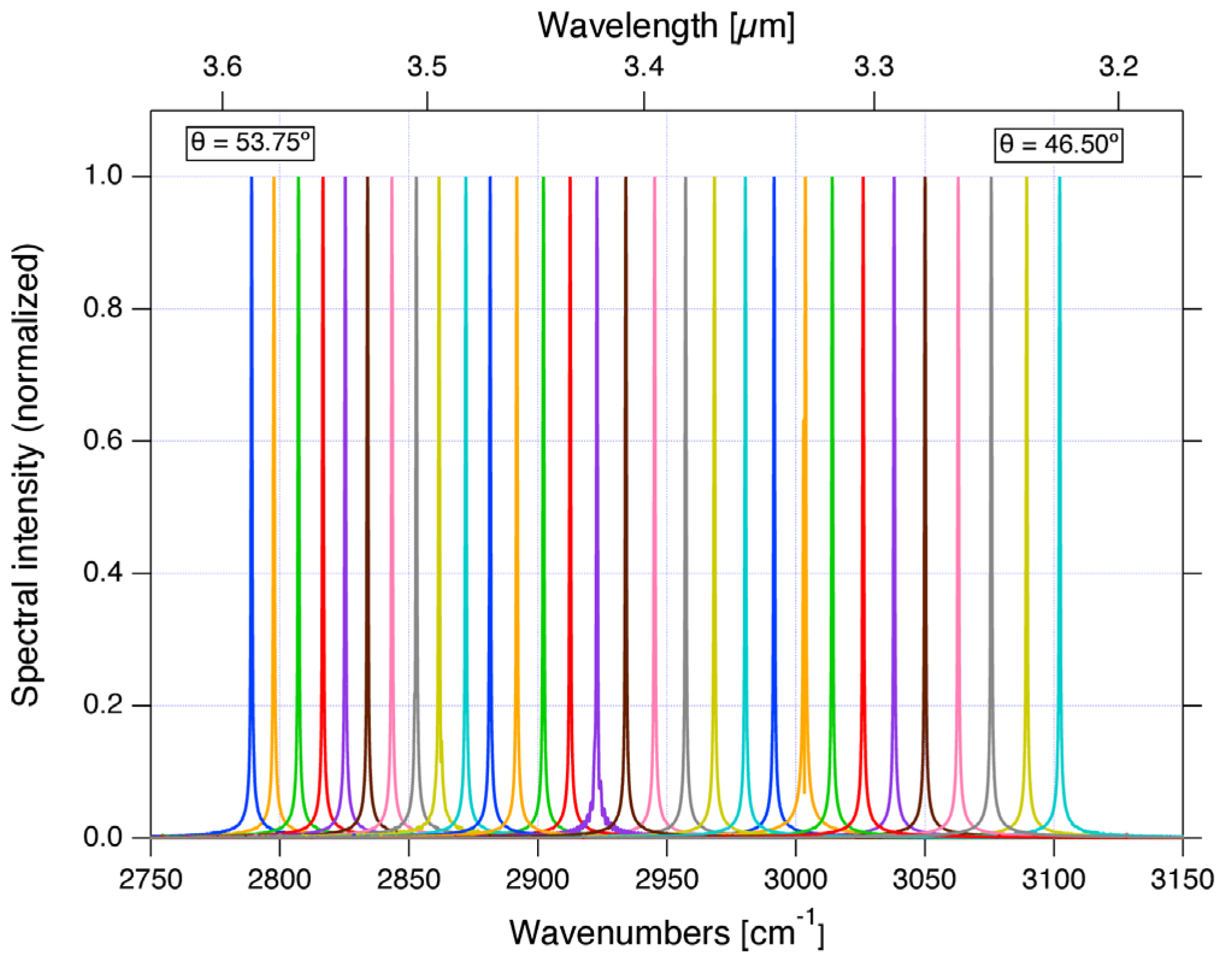


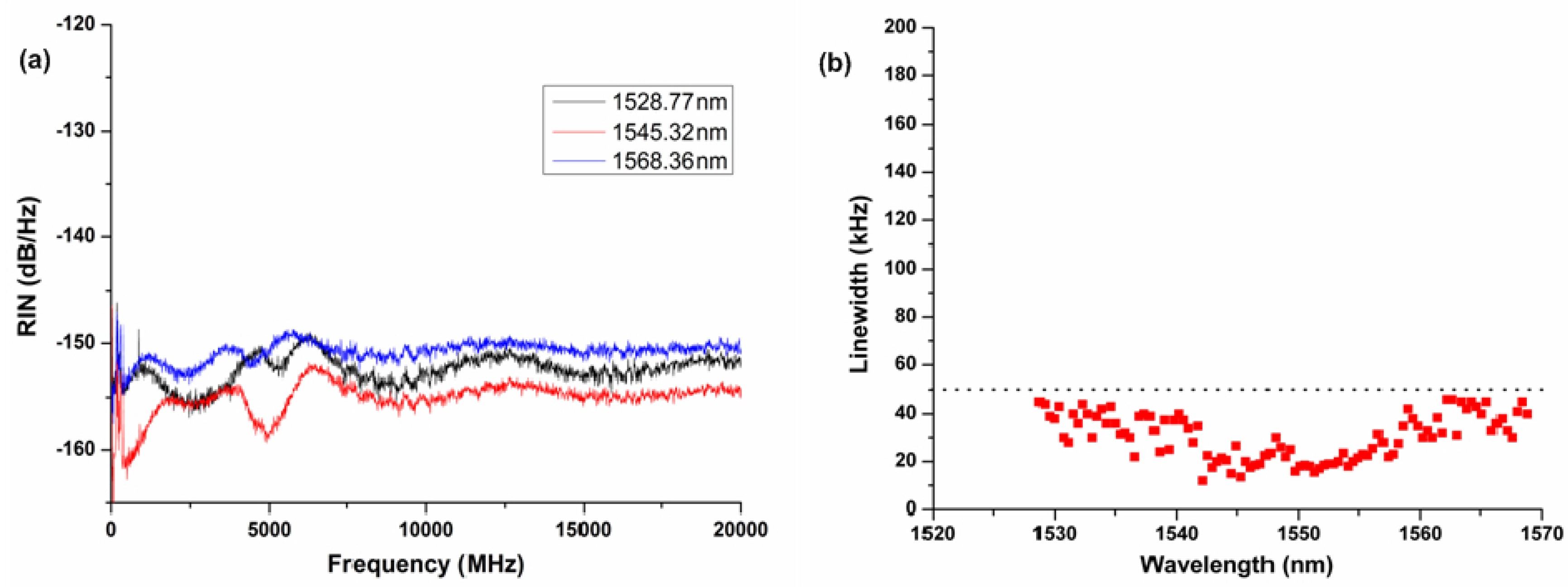





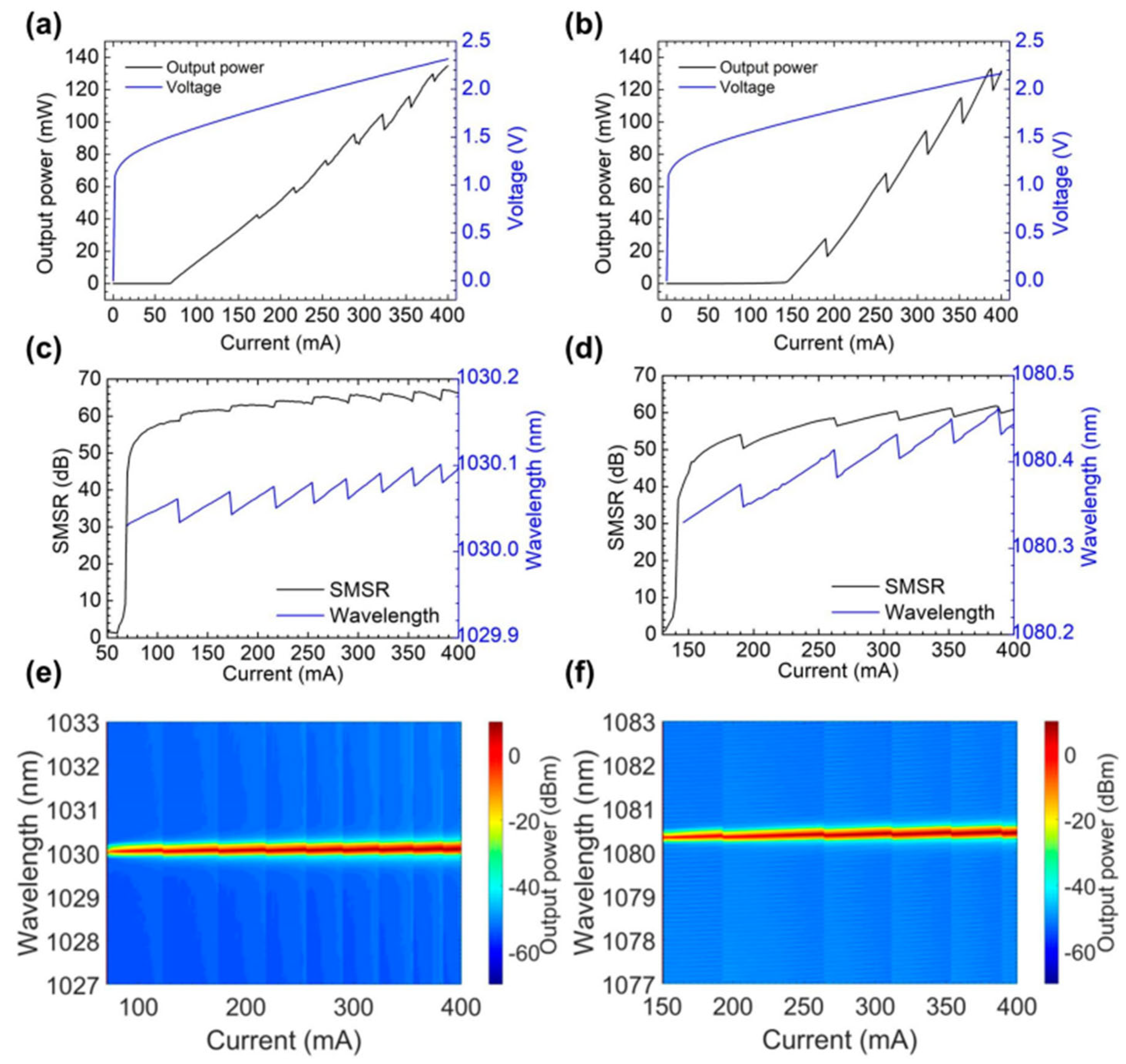

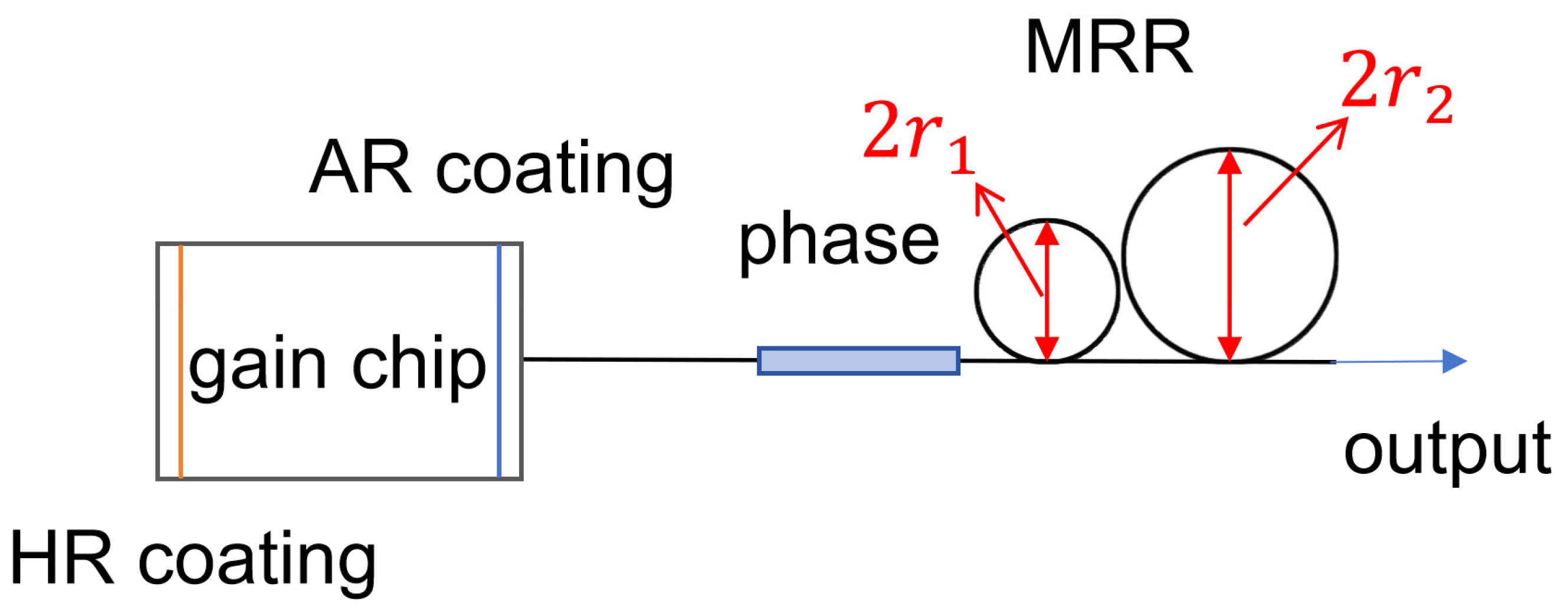

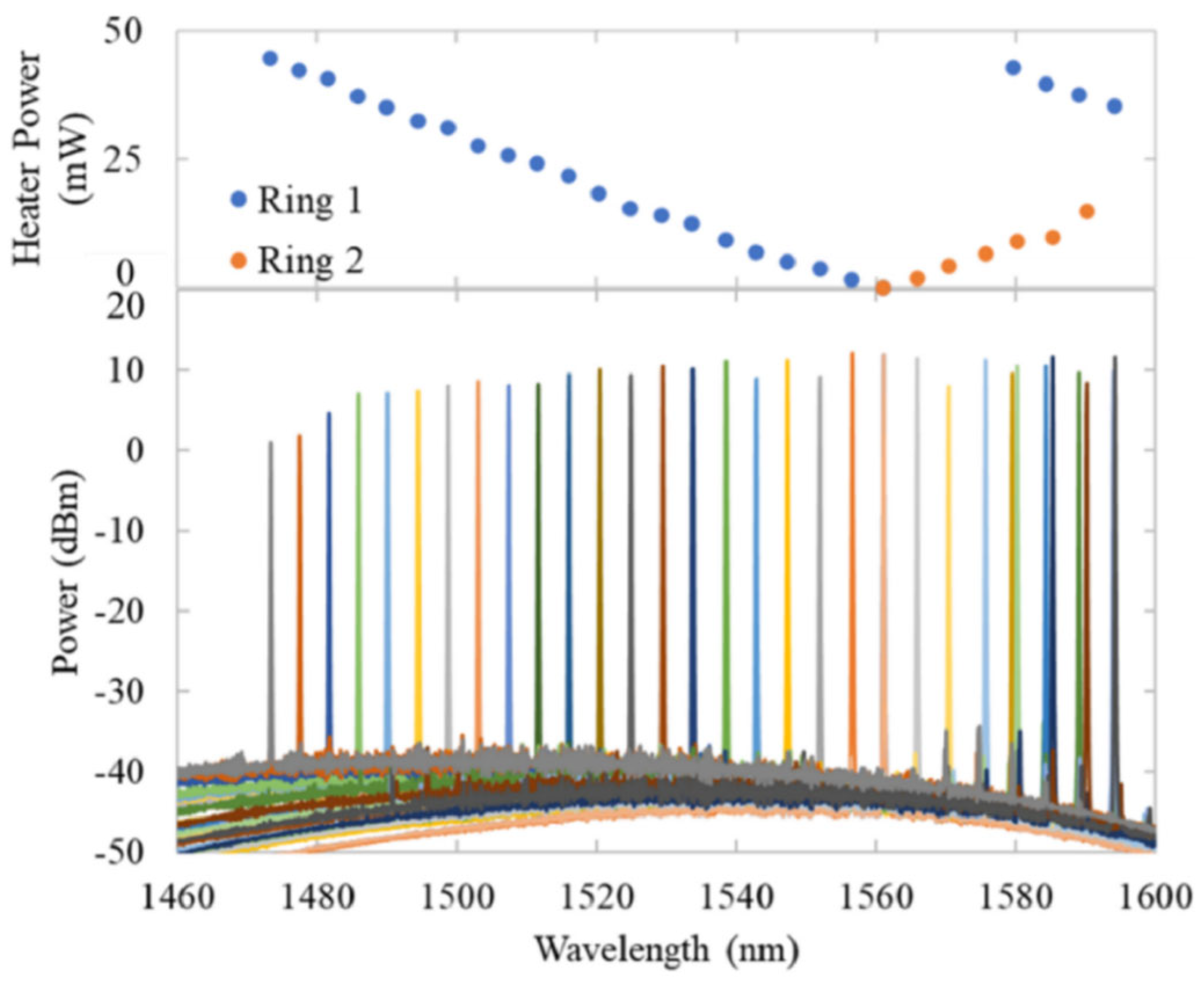
| Type | Tuning Range (nm) | Wavelength Coverage (nm) | Linewidth | SMSR (dB) | Current (mA) | Power (mW) | Year |
|---|---|---|---|---|---|---|---|
| Littrow | 120 | 1860–1980 | 20 kHz | - | 400 | 9.3 | 2020 [14] |
| Littrow | 360 | 3220–3580 | - | 35 | 192 | 13 | 2021 [15] |
| Littrow | 9 | 773.5–782.5 | 0.17 nm | 20 | 7000 | 3050 | 2024 [16] |
| Littrow | 8.6 | 439.4–448 | 30 pm | - | 400 | 36 | 2025 [17] |
| Type | Tuning Range (nm) | Wavelength Coverage (nm) | Linewidth | SMSR (dB) | Current (mA) | Power (mW) | Year |
|---|---|---|---|---|---|---|---|
| Littman | 9.88 | 797.38–807.26 | 0.06 nm | 20 | - | 17.9 | 2003 [22] |
| Littman | 40 | 1528.77–1568.36 | 50 kHz | 55 | 300 | 19.95 | 2012 [24] |
| Littman | 52 | 829.2–881.5 | 0.27 nm | - | 150 | 20 | 2018 [25] |
| Littman | 59.13 | 1520.82–1579.95 | 100 kHz | - | - | 30.2 | 2022 [28] |
| Littman | 100 | 1520–1620 | - | 65.64 | - | 25.82 | 2023 [29] |
| Littman | 70 | 690–760 | 1.5 pm | - | - | 2350 | 2023 [30] |
| Littman | 180 | 1450–1630 | 1.63 kHz | 71.03 | - | - | 2025 [31] |
| Littman | 0.817 | 442.993–443.265 | 0.321 nm | - | 2400 | 4980 | 2025 [32] |
| Filter Type | Tuning Range (nm) | Wavelength Coverage (nm) | Linewidth | SMSR (dB) | Current (mA) | Power (mW) | Year |
|---|---|---|---|---|---|---|---|
| FP | 40 | 15XX–15XX | 100 kHz | 60 | 400 | 25 | 2011 [36] |
| TF | 48 | 1550.67–1598.78 | 10.1 kHz | 55 | 100 | - | 2019 [40] |
| IF | 0.065 | 498 | 180 kHz | - | 65 | 35 | 2020 [37] |
| BRF | 71 | 1124–1195 | 1.7 nm | - | - | 2850 | 2021 [41] |
| MRRs | 55 | 1529.37–1584.13 | 2.37 kHz | 51.6 | 1500 | 240 | 2023 [42] |
| IF | 1.07 | 779.07–781.04 | 0.57 kHz | 54 | 100 | 14 | 2024 [43] |
| IF | 0.076 | 780.212–780.288 | 55 kHz | - | 95 | 51 | 2025 [44] |
| Fiber Type | Tuning Range (nm) | Wavelength Coverage (nm) | Linewidth | SMSR (dB) | Current (mA) | Power (mW) | Year |
|---|---|---|---|---|---|---|---|
| FBG | 1.5 | - | 10 kHz | 30 | 175 | 10 | 2014 [46] |
| CFBG | 35 | 1535–1570 | 0.14 nm | - | 480 | 316,227.7 | 2020 [47] |
| FBG | - | - | 16 kHz | 44 | 95 | 1.3 | 2021 [48] |
| FBG | 0.0453 | 1080 | 260.5 kHz | 66.3 | 400 | 134.6 | 2022 [49] |
| FBG | 2.5 | 1549.5–1552 | 0.6 kHz | 43 | - | 10.4 | 2023 [50] |
| FBG | 2 | 1549–1551 | 100 kHz | 45 | 400 | 95 | 2024 [51] |
| FFPTF | 226.8 | 1435.7–1662.5 | - | - | 900 | 160 | 2025 [52] |
| Spectral Selection Element | Tuning Range (nm) | Wavelength Coverage (nm) | Linewidth | SMSR (dB) | Current (mA) | Power (mW) | Year |
|---|---|---|---|---|---|---|---|
| Bragg grating | - | - | 18 kHz | 40 | - | 7 | 2006 [62] |
| MRRs | 14.5 | 1542.7–1557.2 | - | 30 | 120 | 0.6 | 2011 [64] |
| Ring resonator | 54 | 1237.7–1292.4 | 50 kHz | 45 | 70 | 10 | 2015 [65] |
| MRRs | 66 | 1881–1947 | 35 kHz | - | 450 | 28 | 2020 [67] |
| MRRs | - | 1548 | 1 kHz | 54 | 300 | 25 | 2021 [68] |
| Bragg grating | - | 155X–155X | 4.15 kHz | 50.2 | 410 | 8.07 | 2021 [69] |
| Blazed grating | 101 | 1909–2010 | 15.1 MHz | 56.26 | 250 | 35.12 | 2021 [70] |
| Ring resonator | 32 | 1529–1561 | 27 kHz | 44 | 75 | 2.3 | 2022 [71] |
| Ring resonator | 120.9 | 1473.3–1594.2 | - | 42 | 200 | 9.15 | 2023 [72] |
| Ring resonator | 89 | 15XX–15XX | 0.252 kHz | 50 | - | 101.4 | 2025 [73] |
Disclaimer/Publisher’s Note: The statements, opinions and data contained in all publications are solely those of the individual author(s) and contributor(s) and not of MDPI and/or the editor(s). MDPI and/or the editor(s) disclaim responsibility for any injury to people or property resulting from any ideas, methods, instructions or products referred to in the content. |
© 2025 by the authors. Licensee MDPI, Basel, Switzerland. This article is an open access article distributed under the terms and conditions of the Creative Commons Attribution (CC BY) license (https://creativecommons.org/licenses/by/4.0/).
Share and Cite
Luo, W.; Chen, J.; Yang, C.; Li, S.; Lou, Y.; Zhu, E.; Yu, S.; Wu, X.; Gao, X.; Xu, D.; et al. Research Progress on Tunable External Cavity Semiconductor Lasers in Visible and Near-Infrared Wavebands. Coatings 2025, 15, 1010. https://doi.org/10.3390/coatings15091010
Luo W, Chen J, Yang C, Li S, Lou Y, Zhu E, Yu S, Wu X, Gao X, Xu D, et al. Research Progress on Tunable External Cavity Semiconductor Lasers in Visible and Near-Infrared Wavebands. Coatings. 2025; 15(9):1010. https://doi.org/10.3390/coatings15091010
Chicago/Turabian StyleLuo, Wei, Jie Chen, Canyuan Yang, Shenglan Li, Yue Lou, Enning Zhu, Shaoyi Yu, Xinyi Wu, Xiaofei Gao, Dongxin Xu, and et al. 2025. "Research Progress on Tunable External Cavity Semiconductor Lasers in Visible and Near-Infrared Wavebands" Coatings 15, no. 9: 1010. https://doi.org/10.3390/coatings15091010
APA StyleLuo, W., Chen, J., Yang, C., Li, S., Lou, Y., Zhu, E., Yu, S., Wu, X., Gao, X., Xu, D., Li, Z., Qu, Y., & Li, L. (2025). Research Progress on Tunable External Cavity Semiconductor Lasers in Visible and Near-Infrared Wavebands. Coatings, 15(9), 1010. https://doi.org/10.3390/coatings15091010







